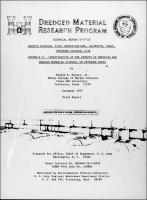Please use this identifier to cite or link to this item:
https://hdl.handle.net/11681/47741| Title: | Aquatic disposal field investigations, Galveston, Texas, offshore disposal site : appendix C : investigation of the effects of dredging and dredged material disposal on offshore biota |
| Authors: | Harper, Donald Ernest, 1940- |
| Keywords: | Sedimentation and deposition Water quality Sediment transport Dredging Dredged material Dredging spoil Galveston (Tex.) Aquatic ecology Dredged Material Research Program (U.S.) |
| Publisher: | U.S. Army Engineer Waterways Experiment Station |
| Series/Report no.: | Technical Report (Dredged Material Research Program (U.S.)) ; no. Technical Report D-77-20; Appendix C |
| Abstract: | This study was part of an investigation to determine the environmental effects of offshore dredged material disposal at Galveston, Texas. The biological portion of the study was conducted in two phases: a pilot survey of the dredged material disposal site (DMDS) to determine the areal distribution of the biota and sediments; and an experimental study to assess the effect of dredged material disposal on the biota at selected sites in the DMDS. Three experimental sites were investigated: a sandy bottom that received sand, shell, and silt-clay dredged material; a muddy bottom that received sand and shell dredged material; and a muddy bottom that received silt-clay dredged material. Dredged material disposal did not appear to have an acute impact on the benthos at any disposal site; any effect was masked by natural population fluctuations following disposal. However, subsequent alterations in benthic populations may have occurred: Beaumont Clay appeared to have a depressive effect while sand-shell dredged material deposited on a muddy bottom appeared to have a stimulative effect. Benthic populations in the ship channel were reduced by dredging, but began to recover as soon as sediments began to accumulate in the channel bottom. The magnitude of the effect on the benthic populations could not be accurately assessed because adequate predisposal data on natural sediment and benthic population changes were not available. Dredged material deposits had no apparent effect on feeding habits of fish or on the distribution of nekton, although some nektonic species may have congregated in the turbid water following dredged material disposal. Zooplankton and phytoplankton studies detected no population changes during disposal that could not have been due to sampling error. It is probable that sudden abiotic changes and commercial fishing activities cause more destruction of biota than dredging-related activities. |
| Description: | Technical Report |
| Gov't Doc #: | Technical Report D-77-20; Appendix C |
| Rights: | Approved for Public Release; Distribution is Unlimited |
| URI: | https://hdl.handle.net/11681/47741 |
| Appears in Collections: | Technical Report |
Files in This Item:
| File | Description | Size | Format | |
|---|---|---|---|---|
| Technical Report D-77-20 Appendix C.pdf | 43.21 MB | Adobe PDF |  View/Open |